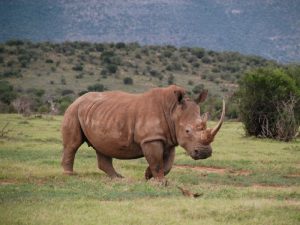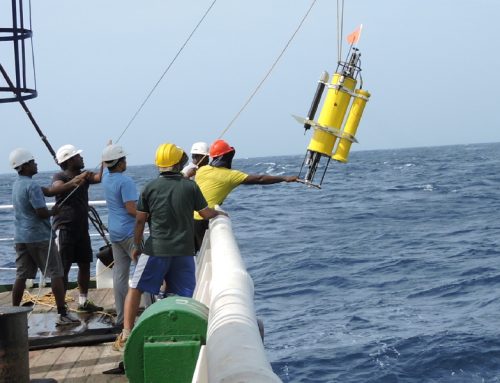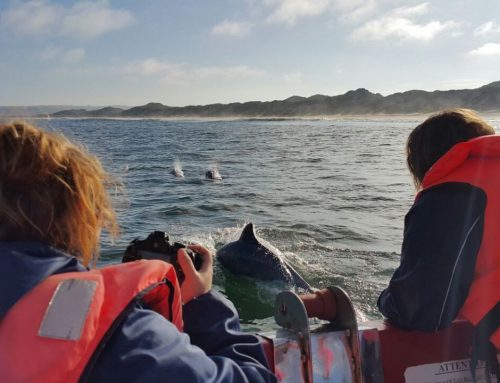By Heather Dugmore
 Africa’s unique megaherbivores – elephants, rhinos and hippos – could potentially play a major role in mitigating climate change, says Distinguished Professor Graham Kerley, Director of the Centre for African Conservation Ecology at Nelson Mandela University.
Africa’s unique megaherbivores – elephants, rhinos and hippos – could potentially play a major role in mitigating climate change, says Distinguished Professor Graham Kerley, Director of the Centre for African Conservation Ecology at Nelson Mandela University.
He is one of six authors of a paper attracting global attention that was published on 22 October in the prestigious journal Philosophical Transactions, which publishes leading scientific thought and discoveries. The paper is titled Trophic rewilding as a climate mitigation strategy? and Kerley’s co-authors are from Sweden, South Africa, The Netherlands and New Mexico.
“The Nobel prize for economics just been awarded to people who work on climate change as it is the biggest threat facing society; far bigger than global terrorism, and it will affect everyone,” says Kerley.
“What we urgently need to do worldwide is to find new ways in which we can intervene on a largescale, and it is obvious that these interventions should be put together in a broad frame,” Kerley explains. “We already have various strategies and goals about carbon emission reduction and carbon sequestration but what are the additional opportunities out there that can significantly contribute to the toolbox of climate change mitigation? This study looks at an area that has not been addressed previously: the role of large/megaherbivores in mitigating climate change.”
The study emanates from speculative discussion between scientists at a global level and proposes a fascinating approach with Africa as the living laboratory. Unlike the rest of the world, we have not lost our megaherbivores, and we are therefore perfectly placed to lead the world in understanding how these animals influence the landscape and climate.
“As a starting point, we need to understand that the megaherbivore communities globally have significantly changed over the last 15 – 20 000 years,” Kerley explains. “Before then, the world was dominated by megaherbivores, but since then North America, South America and most of Eurasia have lost all their megaherbivores, including the mammoth, mastodon, gomphothere (four-tusk elephant), giant ground sloth, and woolly rhinoceros.
“This is a very recent extinction and the consequences have been profound in terms of how the climate has shifted due to the largescale loss of megaherbivores worldwide. Megaherbivores, which are hind gut fermenters that produce far less methane, have since largely been replaced with livestock, particularly sheep and cattle industry, which produces far more methane.
“Today, we define a megaherbivore as an animal weighing over 1000 kilograms,” Kerley continues. “The prehistoric megaherbivores were far larger and heavier than the megaherbivores of today still found in Africa, where our elephants, for example date back several million years. In South Africa, megaherbivores would have occurred just about everywhere except the very dry areas like the Kalahari, and the hippos would have inhabited the water course areas.”
The reason that Africa is the only continent that has retained its megaherbivores and in sizeable numbers is attributed in some of the literature to humans and megaherbivores having co-evolved in Africa. The megaherbivores were therefore more alert to human hunting, whereas when humans moved out of Africa, the megaherbivores were naïve to human hunting, and easy prey.
The rapid decline in megaherbivores is attributed to the slow life history of these big animals. Thus with their lengthy gestation period and slow growth, reproduction by megaherbivores could not keep up with the assault. In Africa, conservation initiatives were fortunately put in place before the megaherbivores were hunted to extinction, but the current poaching onslaught is expected to reverse the recent growth in their numbers.
The impact on the global climate as a result of the mass loss of megaherbivores in other parts of the world is finally being understood, and is explained in the paper in terms of what these animals contribute to climate change mitigation, as Kerley explains:
“The mega browsers (in Africa these are the black rhino and elephant) help to maintain the balance in savanna systems between trees and grasslands, working in synergy with the mega grazers. Without the mega browsers, trees and bushes would take over the grasslands, and without the mega grazers, grasslands would take over the tree and forest areas.
“The importance of vast areas of grassland, in addition to their role as water production areas, is that they reflect the sunshine, and therefore reduce solar radiation. This might prove to be even more important in keeping the planet cool than dark areas, such as trees and forests which absorb heat and carbon and play an important role in carbon sequestration (long-term carbon storage).
“The megaherbivores also play a major role in nutrient recycling, soil health and seed dispersal. Elephants, for example, contribute to the dispersal of the seeds for hardwood trees and are therefore essential to the growth of hardwoods that grow slowly and hold their carbon for long periods.”
The authors emphasise that the megaherbivore proposition is not a single solution, it is a contribution to the climate change mitigation strategy
“The latest report from the Intergovernmental Panel on Climate (IPCC) states that we have to do a lot more to keep the world from warming by more than 1.5°C and to reverse the changes to the atmosphere in order to avoid catastrophic climate consequences, including largescale extinction,” says Kerley.
He refers to an article in The Conservation Africa on 10 October 2018 by systems ecologist Professor Robert Scholes from Wits University’s Global Change Institute (GCI) who writes: It seems inevitable that the planet will overshoot the 1.5°C global mark, and probably also the 2°C mark. Cooling the atmosphere later in the century would require the removal of up to a trillion tonnes of carbon dioxide. The world doesn’t yet have affordable, proven technology to do this at the required scale. The approach that is most commonly punted – mass tree-planting – is a non-starter in most of southern Africa, where the arable land and water resources are needed for food production, and the marginal land is too dry to grow forests.
Given the potential of megaherbivores as an option in support of climate change mitigation, it raises the interesting discussion of what it would mean to reintroduce megaherbivores into Eurasia, North America and South America where they have been driven extinct by humans.
“We need to do far more research into this, with many questions to be answered. These include: If you have an equal biomass of elephants and cattle, what happens to respective landscapes when you have systems dominated by megaherbivores and wildlife versus systems dominated by domestic livestock? What are the implications for climate mitigation, land use and food security? Will the world need to create larger areas for megaherbivores and other wildlife? How are we managing our wildlife for climate change mitigation? What are the consequences of not having megaherbivores?
“If megaherbivores do play a significant role in climate change mitigation, Africa could play a major environmental and economic role in making them available to the rest of the world. Would the world be open to this, are we ready for this? All these ideas and questions are somewhat speculative, but we need to explore them, and, as a matter of great urgency, come up with new, largescale, innovative climate mitigation strategies.”
Title of paper: Trophic rewilding as a climate change mitigation strategy?
Title of journal: Philosophical Transactions
Date of publication: 25 October 2018
Authors: Joris P. G. M. Cromsigt1,2,3, Mariska te Beest3,4, Graham I. H. Kerley2,
Marietjie Landman2, Elizabeth le Roux2 and Felisa A. Smith5
1Department of Wildlife, Fish and Environmental Studies, Swedish University of Agricultural Sciences, Sweden
2Centre for African Conservation Ecology, Department of Zoology, Nelson Mandela University, South Africa
3Environmental Sciences, Copernicus Institute of Sustainable Development, Utrecht University, The Netherlands
4South African Environmental Observation Network, South Africa
5Department of Biology, University of New Mexico, Albuquerque, USA
Philosophical Transactions − the world’s first science journal
In 1662, the newly formed ‘Royal Society of London for Improving Natural Knowledge’ was granted a charter to publish by King Charles II and on 6 March 1665, the first issue of Philosophical Transactions was published under the visionary editorship of Henry Oldenburg, who was also the Secretary of the Society. The first volumes of what was the world’s first scientific journal were very different from today’s journal, but in essence it served the same function; namely to inform the Fellows of the Society and other interested readers of the latest scientific discoveries. As such, Philosophical Transactions established the important principles of scientific priority and peer review, which have become the central foundations of scientific journals ever since. In 1886, the breadth and scope of scientific discovery had increased to such an extent that it became necessary to divide the journal into two, Philosophical Transactions A and B, covering the physical sciences and the life sciences respectively.
Source: http://rstl.royalsocietypublishing.org/




